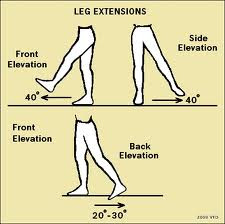Hip replacement surgery is more common in the obese population, because obese women and men are more likely to suffer from hip osteoarthritis (wearing away or degeneration of the cartilage in the hip's ball and socket structure).
Despite what the "health at any size" movement insists, obesity is a major hardship on the body and causes more complications after surgeries, than in leaner patients, and hip replacement is no exception to this rule.
However, just how obesity affects the outcome or results of hip replacement surgery in women, is not the same as in men, says research from Geneva University Hospital in Geneva, Switzerland. The study involved 2,495 hip replacements over a 10-year period, of which 589 were on obese patients.
The following elements were evaluated: dislocation, infection, redoing the surgery, satisfaction with the surgery, quality of life, and general health. Most of the plus-size patients were men, but for the heavy women, obesity was tied to a much greater risk for infection, and it brought on more dislocations than in the men, resulting in surgical revisions.
The large women reported medium-level lower functional outcomes, but the large men didn't report any. The obese women also reported a little less satisfaction, and most of this came from the higher rate of complications.
In short, the obese women had poorer results from their hip replacements, but strangely, the risk factors for infection that more often strike heavy patients, did not apply to the women in the study.
The researchers aren't sure what could explain this, but suggest possibly it could be differences in body fat distribution between the genders, and maybe even metabolic response.
some cases: testimonial :
I was a very healthy, athletic woman of 54 when I first experienced a pain in my left groin area doing flip-turn kicks off the end of the swimming pool as I was doing my 1/2 mile of daily laps. Over several weeks and then months the pain became more acute and chronic, so that I was experiencing severe pain 24/7 and not just while doing certain movements. Pain was with me all-day - sometimes so intense as to bring tears to my eyes and ruining whole nights of sleep. Finally I relented in my stubborn refusal to admit that something was really wrong with my hip and saw my orthopedic surgeon. It only took one x-ray of both hips for him to come to his conclusion. No ands, ifs, or buts-I had severe hip displasia, which I had been born with and which had been eating away at my cartilage for all my adult life. This condition is really a sort of birth defect in a sense. The hip sockets that the ball joints of the femur fits into are extremely shallow and the cushioning material that protects the hips are worn down very fast in an individual with this condition. My doctor prescribed me VIOXX and sent me home, saying that at some point I would probably need to have a total replacement of my left hip.
Despite what the "health at any size" movement insists, obesity is a major hardship on the body and causes more complications after surgeries, than in leaner patients, and hip replacement is no exception to this rule.
However, just how obesity affects the outcome or results of hip replacement surgery in women, is not the same as in men, says research from Geneva University Hospital in Geneva, Switzerland. The study involved 2,495 hip replacements over a 10-year period, of which 589 were on obese patients.
The following elements were evaluated: dislocation, infection, redoing the surgery, satisfaction with the surgery, quality of life, and general health. Most of the plus-size patients were men, but for the heavy women, obesity was tied to a much greater risk for infection, and it brought on more dislocations than in the men, resulting in surgical revisions.
The large women reported medium-level lower functional outcomes, but the large men didn't report any. The obese women also reported a little less satisfaction, and most of this came from the higher rate of complications.
In short, the obese women had poorer results from their hip replacements, but strangely, the risk factors for infection that more often strike heavy patients, did not apply to the women in the study.
The researchers aren't sure what could explain this, but suggest possibly it could be differences in body fat distribution between the genders, and maybe even metabolic response.
some cases: testimonial :
I was a very healthy, athletic woman of 54 when I first experienced a pain in my left groin area doing flip-turn kicks off the end of the swimming pool as I was doing my 1/2 mile of daily laps. Over several weeks and then months the pain became more acute and chronic, so that I was experiencing severe pain 24/7 and not just while doing certain movements. Pain was with me all-day - sometimes so intense as to bring tears to my eyes and ruining whole nights of sleep. Finally I relented in my stubborn refusal to admit that something was really wrong with my hip and saw my orthopedic surgeon. It only took one x-ray of both hips for him to come to his conclusion. No ands, ifs, or buts-I had severe hip displasia, which I had been born with and which had been eating away at my cartilage for all my adult life. This condition is really a sort of birth defect in a sense. The hip sockets that the ball joints of the femur fits into are extremely shallow and the cushioning material that protects the hips are worn down very fast in an individual with this condition. My doctor prescribed me VIOXX and sent me home, saying that at some point I would probably need to have a total replacement of my left hip.
 10:04 PM
10:04 PM
 Nbila rew
Nbila rew
 Posted in
Posted in







